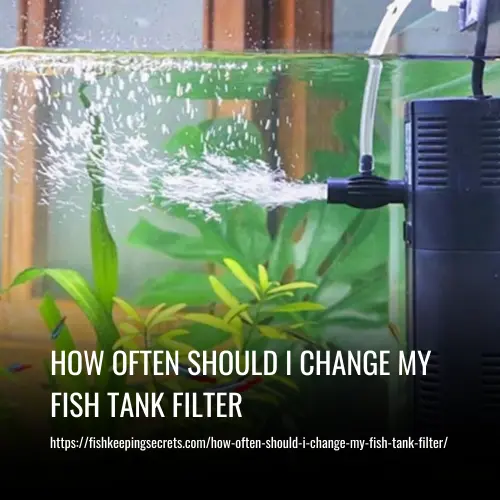How to Fix a Leak in a Fish Tank: Quick Solutions.
This post contains affiliate links. As an Amazon Associate, we earn from qualifying purchases.
To fix a leak in a fish tank, firstly, you need to identify the exact location of the leak. Once you have done that, you can fix the leak with a sealant appropriate for fish tanks or replace the affected glass panel.
A leak in your fish tank can be frustrating and potentially harmful to your aquatic pets. It can not only damage the tank but can also cause a significant loss of water, which may affect the water quality and adversely impact the life inside.
So, it’s important to fix it promptly and properly. In this article, we will discuss some tips and steps to help you fix a leak in your fish tank quickly and efficiently, ensuring the safety and well-being of your fish.

Steps To Fixing A Leak In A Fish Tank
Fixing a leak in a fish tank can be a tricky task if you don’t know what you’re doing. Leaks can occur due to various reasons such as damage to the glass or silicone sealant. But the good news is that fixing a leak in a fish tank is a straightforward process.
We’ll show you how to fix a leak in a fish tank in a few easy, actionable steps using silicone sealant or aquarium glue.
Preparation Before Fixing The Leak
Before you begin fixing the leak, there are a few things you need to do to ensure that the process goes as smoothly as possible. Here are some of the essential steps you should take before you start repairing the leak:
- Unplug the electrical equipment: The first and most crucial step is to unplug all the electrical equipment connected to the tank, such as the filter, heater, and lights.
- Empty the tank: Drain the water out of the tank and remove all the fish, plants, and other decorations. Place these items in a separate container filled with aquarium water to keep them safe.
- Clean the tank: Clean the tank thoroughly using a cloth or paper towel, and remove any debris or residue from the area around the leak. This will ensure that the sealant adheres properly to the glass.
- Identify the leak: Find the source of the leak so you know exactly where to apply the sealant.
Step-By-Step Guide On Fixing The Leak Using Silicone Sealant Or Aquarium Glue
Now that you’re fully prepared, you can start fixing the leak in your fish tank. Here’s a step-by-step guide on how to fix a leak in a fish tank using silicone sealant or aquarium glue:
- Step 1: Dry the surface around the leak: use a dry cloth or paper towel to dry the area around the leak completely.
- Step 2: Apply the sealant: using a caulking gun, apply the silicone sealant or aquarium glue directly to the leak. Make sure to apply enough to cover the entire leak adequately.
- Step 3: Spread the sealant: use your finger or a putty knife to spread the sealant evenly over the entire area surrounding the leak. Be sure to smooth out any bumps or uneven spots.
- Step 4: Wait for the sealant to dry: the sealant will take about 24 hours to dry completely, depending on the brand. Please do not touch it during this time.
- Step 5: Refill the tank: once the sealant has dried, refill the tank with freshwater, and plug in all the electrical equipment.
Tips For Handling Leaks In Hard-To-Reach Areas
Leaks in hard-to-reach areas can be more challenging to fix. Here are some helpful tips for dealing with these kinds of leaks:
- Use a flashlight to locate the leak: Shine a flashlight on the tank’s outside surface to detect leaks that are not visible from the inside.
- Use a flexible sealant: For leaks in hard-to-reach areas, use a flexible sealant that can fit into small spaces.
- Use a syringe: If the leak is in a particularly tight spot, use a syringe to apply the sealant to the area.
Fixing a leak in a fish tank is a task that requires attention to detail and patience. However, by following these simple steps and tips, you can quickly repair your leak, ensuring the safety of your fish and other aquatic pets.
Understanding The Causes Of Leaks In Fish Tanks
Fishkeeping is an exciting hobby that requires care and maintenance. A common problem faced by aquarium enthusiasts is a leak in the tank. Leaks can be disastrous if not handled promptly, as they can cause irreparable damage to your aquatic pets’ habitat.
Understanding the causes of leaks is the first step in preventing them. Here are the common reasons for leaks in fish tanks.
Common Reasons For Leaks In Fish Tanks
- Cracks or weak seams: Tank walls may crack due to accidents or weak seams during the manufacturing process.
- Wear and tear: Age or rough handling can cause aquarium materials to break down or deteriorate.
- Overcrowding: Placing too many decorations, equipment or aquatic species in a tank can result in added pressure on the tank’s walls, causing leaks
- Poor maintenance: Failing to maintain the tank, such as ignoring regular water changes or cleaning, can lead to a blocked filter or clogged pipes, resulting in increased pressure against the tank’s walls and causing leaks.
How To Locate The Source Of The Leak
The second step in fixing a leak in a fish tank is by identifying the source of the leak. Here’s how to locate the leak in your aquarium:
- Inspect the tank: Start by checking the walls, corners, bottom, and seams of your tank. Carefully use a towel to wipe the outer walls of the tank, checking for any signs of moisture.
- Check equipment and accessories: Inspect your tank’s equipment such as the filter, heater, and other accessories attached to the tank.
- Peform a water test: Carefully remove the tank’s inhabitants and drain the water, and place the tank in a new location. Refill the tank halfway with water then check for leaks.
With these tips, you can quickly locate the source of the leak and take steps towards having a leak-free fish tank.
Quick Fixes For Leaks In Fish Tanks
Fish tanks are a wonderful addition to any home, but a leak can be a catastrophe for your aquatic friends. Replacing a fish tank can be expensive, but with a little diy knowledge, it’s possible to fix small leaks quickly and easily.
In this section, we will explore three quick solutions for fixing leaks in fish tanks.
Using Silicone Sealant To Fix Small Leaks
For small leaks, silicone sealant is an excellent solution. It’s waterproof and long-lasting, which makes it an ideal material to repair your fish tank. Here are the key points to follow to use silicone sealant safely and efficiently:
- First, remove all the water and fish from the tank.
- Dry the tank completely with a clean cloth.
- Identify the location of the leak.
- Apply silicone sealant to the leak according to the manufacturer’s instructions.
- Leave the sealant until it is completely dry, then add water to the tank and return your fish.
Applying Aquarium Glue To Fix Large Leaks
If you have a large leak, aquarium glue is your best bet. Aquarium glue is stronger than silicone and specially formulated to work underwater. Here are the key points to follow when using aquarium glue:
- Remove all the water and fish from the tank.
- Dry the tank completely with a clean cloth.
- Identify the location of the leak.
- Apply aquarium glue to the leak according to the manufacturer’s instructions.
- Allow the glue to dry completely, then refill the tank with water and return your fish.
Using A Temporary Solution (Duct Tape) In Emergencies
When your fish tank is leaking, and you don’t have silicone sealant or aquarium glue, duct tape can be a temporary fix until you have access to a permanent solution. Here are the key points to keep in mind when using duct tape:
- Remove all the water and fish from the tank.
- Dry the tank completely with a clean cloth.
- Identify the location of the leak.
- Wrap duct tape around the leak.
- Refill the tank slowly and keep an eye on the area covered in duct tape.
- Replace the duct tape with a permanent solution as soon as possible.
Fixing a leak in a fish tank is possible, and it’s essential to act quickly to ensure the safety of your aquatic friends. Remember, these three quick solutions are all temporary fixes, and it’s best to order a replacement tank as soon as possible.
Preventing Leaks In Fish Tanks
There’s nothing more frustrating for a fish keeper than a leak in their aquarium. Not only can it cause damage to your home or office, but it can also put your beloved fish at risk. Luckily, there are steps you can take to prevent leaks from happening in the first place.
Here are some tips to get you started:
Regular Tank Maintenance And Inspections
Regular maintenance and inspections of your fish tank are critical to keeping it leak-free. You should perform the following tasks at least once a month:
- Check for cracks, leaks, or any other damage to the tank and its accessories
- Replace any worn or damaged parts such as seals, gaskets, and tubing
- Clean the tank and its accessories thoroughly to prevent buildup of algae or debris
- Check the water level and adjust as needed
- Test the water quality to ensure your fish are living in a healthy environment
Choosing The Right Tank And Accessories To Prevent Leaks
The type and quality of your tank and accessories play a crucial role in preventing leaks. Here are some things to consider when selecting your tank:
- Choose a tank made of tempered glass or acrylic, as they are less likely to crack or leak
- Ensure your tank comes with high-quality seals, gaskets, and tubing
- Avoid placing your tank on an unstable or uneven surface that could cause it to crack
- Use a sturdy and level stand that can support the weight of the tank and its contents
Common Mistakes To Avoid In Tank Setup And Maintenance
Making mistakes during tank setup and maintenance can lead to leaks. Here are some common errors to avoid:
- Overfilling the tank can put pressure on seals and cause leaks
- Not tightening fittings and connections enough can allow water to seep out
- Using cleaning products that contain chemicals can damage seals and cause leaks
- Ignoring signs of damage or wear and tear can lead to larger problems down the road
By following these tips, you’ll be well on your way to preventing leaks from happening in your fish tank. Regular maintenance, proper equipment selection, and attention to detail are key to keeping your fish and your home safe and secure.
When To Seek Professional Help
While fixing a leak in a fish tank can often be done by following the steps outlined above, there are instances where it may be necessary to seek professional help. Here are some situations when you should consider contacting a professional:
- Large leaks: If your fish tank has a large leak, it is usually beyond a diy repair. Large leaks can cause significant damage to your floor and other nearby items.
- Structural damage: If your fish tank has any cracks or other structural damage, it is best to consult a professional. Structural damage can pose a significant risk to your fish and other aquatic animals.
- Limited experience: If you have limited experience fixing aquarium leaks, it is best to seek professional help. Attempting to fix the leak yourself can lead to further damage to your fish tank and the aquatic life inside it.
How To Find A Qualified Aquarium Repair Technician
Finding the right aquarium repair technician is essential to fix the leak in your fish tank. Here are some tips to find a qualified aquarium repair technician:
- Look for reviews: Look for customer reviews on websites like yelp or google. Reviews can give you an idea of the technician’s work quality and customer service.
- Check certification: Ensure that the technician is certified to work on aquariums. You can verify their certification with the professional aquarium service technician association.
- Ask for referrals: Ask for referrals from other fish tank owners in your community. They may recommend a reliable and trustworthy aquarium repair technician.
Cost Considerations For Professional Repairs
Professional repairs can be a smart investment for your fish tank, but they can also be costly. Here are some cost considerations for professional repairs:
- Distance of technician: The distance between your location and the technician’s location can impact the cost of repairs. A technician who is far away may charge extra for travel expenses.
- Complexity of the leak: The complexity of the leak can also impact the cost of repairs. A relatively simple leak can be fixed in a short amount of time, while a more complex leak may require more work and time, which can increase the cost of repairs.
- Technician’s experience: An experienced aquarium repair technician may charge more than a new technician. However, an experienced technician may complete the repair more quickly and effectively, saving you money in the long run.
Finding the right solution for your fish tank leak requires careful consideration. While you may attempt to fix minor leaks yourself, it is best to consult with a qualified aquarium repair technician for more complicated leaks.
Recap Of Quick Solutions For Fish Tank Leaks
Fixing a leak in a fish tank can be daunting, especially for beginners. Prompt leak repair is crucial to avoid further damage to your aquarium and keep your fish healthy. Here is a quick summary of the solutions covered :
- Identify the leak and its cause before beginning any repair work.
- Use a silicone sealant to seal small cracks or gaps in the tank.
- For larger leaks, use a repair kit or diy solution, such as fiberglass or a glass patch.
- Consider using aquarium-safe putty or tape for minor leaks and temporary solutions.
Emphasize The Importance Of Prompt Leak Repair
Ignoring a leak can have severe consequences for your fish and their environment. Even a small leak can cause water to drain quickly, leading to an oxygen-depleted tank and potential harm to your fish. Promptly repairing a leak also prevents water damage to furniture, walls, and floors.
It’s essential to address the issue before it gets worse and potentially leads to costly repairs.
Encourage Prevention Tips To Avoid Future Leaks
Prevention is always better than cure. Following these tips can help you avoid future leaks and keep your fish tank in top condition:
- Regularly inspect the tank for cracks, leaks, and other damage.
- Use high-quality aquarium silicone sealants and be consistent with maintenance procedures.
- Avoid placing the tank near sunlight or heat sources to prevent overheating and warping of the glass or acrylic.
- Be cautious with aquarium decorations and equipment, ensuring they don’t scratch or damage the tank.
By following these tips, you can prevent leaks in your fish tank and enjoy a thriving aquatic environment for your fish and plants.
FAQs
If you notice a decrease in the water level in your tank, it is a sign that your fish tank is leaking. Other symptoms include warping of wood or water damage around the aquarium, or even a sudden change in fish behavior.
Yes, a fish tank leak can be fixed. The best method to repair a leaky fish tank depends on the size of your tank and where the leak is located. Fixing some leaks can be done by using silicone or epoxy adhesive, while more severe leaks may require professional help.
Fish tank leaks can be caused by a number of factors, such as cracks in the tank, age, stress from overfilled tanks, inappropriate placement, or sudden impact. Additionally, mold growth around the tank can also cause leaks or weaken the material over time.
Conclusion
Fixing a leak in a fish tank is a task that requires patience, diligence, and a bit of technical know-how. Identifying the source of the leak, moving the fishes to a temporary habitat, and draining the water from the tank are all crucial steps before attempting to repair the leak.
With simple household items or an aquarium sealant, you can patch up the leak and save your beloved aquatic pets. Remember to let the sealant cure for at least 24 hours before refilling the tank and reintroducing the fishes. Regular maintenance and inspection can prevent any future leaks, ensuring that your fish tank stays a safe and healthy home for your fishes to thrive in.
Happy fish-keeping!






